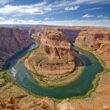Walnut Canyon National Monument is a place of great historical significance in the United States. Located in the state of Arizona, this monument is a testament to the ancient civilizations that once thrived in the area. With its stunning natural beauty and rich cultural heritage, Walnut Canyon National Monument is a must-visit destination for anyone interested in history and nature.
In this article, we will delve deeper into the history and significance of Walnut Canyon National Monument, as well as the various attractions and activities that visitors can enjoy during their visit. We will also provide some practical tips and advice for planning your trip to this amazing destination.
History and Significance
Walnut Canyon National Monument is located in northern Arizona, about 10 miles southeast of Flagstaff. The monument encompasses a deep, narrow canyon that is approximately 20 miles long and 400 feet deep. The canyon was formed over millions of years by the action of Walnut Creek, which carved out the soft sandstone rocks.
The area around Walnut Canyon has been inhabited by humans for thousands of years. The first people to settle here were the ancient Puebloans, who arrived in the area around 600 CE. These early settlers lived in small villages on the canyon rim and in the surrounding areas.
Over time, the Puebloans developed a complex society, building elaborate structures and developing a sophisticated culture. They built multi-story dwellings out of stone and adobe, using sophisticated engineering techniques to support the weight of the buildings. They also developed a complex system of agriculture, relying on irrigation to grow crops in the dry desert climate.
In the 12th century, the Puebloans began to abandon the area around Walnut Canyon. The reasons for their departure are not entirely clear, but it is thought that a combination of environmental factors, including drought and overuse of resources, may have played a role.
After the departure of the Puebloans, the area around Walnut Canyon was inhabited by a number of different groups, including the Hopi and Navajo tribes. In the 19th century, European settlers began to arrive in the area, and the canyon became an important site for ranching and mining.
In 1915, Walnut Canyon was designated a national monument by President Woodrow Wilson. Today, the monument is managed by the National Park Service and is recognized as an important site of cultural and historical significance.
Attractions and Activities
Walnut Canyon National Monument is home to a wide variety of attractions and activities that are sure to appeal to visitors of all ages and interests. Here are some of the top things to see and do during your visit:
- Cliff Dwellings
One of the main attractions at Walnut Canyon National Monument is the cliff dwellings that were built by the ancient Puebloans. These dwellings were built directly into the cliffs that line the canyon, and they provide a fascinating glimpse into the lives of these early settlers.
Visitors can hike down into the canyon and explore the various dwellings, which are remarkably well-preserved considering their age. Many of the dwellings are multi-story structures that were built using stone and adobe, and they offer a fascinating look at the engineering and building techniques of the Puebloans.
- Hiking Trails
Walnut Canyon National Monument is home to a number of hiking trails that offer stunning views of the canyon and the surrounding landscape. Some of the most popular trails include the Island Trail, which takes visitors down into the canyon and past a number of cliff dwellings, and the Rim Trail, which offers panoramic views of the canyon from the rim.
Whether you are an experienced hiker or just looking for a leisurely stroll, there is a trail at Walnut Canyon that is perfect for you.
- Ranger-led Programs
The National Park Service offers a number of ranger-led programs at Walnut Canyon National Monument, including guided tours of the cliff dwellings and hikes that focus on the natural and cultural history of the area. These programs are a great way to learn more about the history and significance of the monument and to gain a deeper appreciation for the natural beauty of the area.
- Picnicking
For those who want to take a break from hiking and exploration, Walnut Canyon National Monument also offers several picnic areas where visitors can relax and enjoy a meal in the great outdoors. These picnic areas are located throughout the monument and offer stunning views of the canyon and surrounding landscape.
- Wildlife Viewing
Walnut Canyon National Monument is home to a wide variety of wildlife, including deer, elk, coyotes, and a variety of bird species. Visitors who are interested in wildlife viewing can take a leisurely walk along one of the monument’s many trails and keep an eye out for animals and birds.
Planning Your Visit
If you are planning a trip to Walnut Canyon National Monument, there are a few things you should keep in mind to ensure that your visit is enjoyable and stress-free:
- Plan ahead: Before you go, be sure to check the National Park Service website for up-to-date information on park hours, fees, and current conditions.
- Dress appropriately: The weather at Walnut Canyon can be unpredictable, so be sure to dress in layers and bring appropriate footwear for hiking.
- Bring plenty of water: The desert climate can be dehydrating, so be sure to bring plenty of water and snacks to keep yourself fueled during your visit.
- Be respectful: Walnut Canyon National Monument is a sacred and culturally significant site, so be sure to show respect and follow all posted rules and regulations.
- Take your time: There is a lot to see and do at Walnut Canyon, so be sure to take your time and enjoy all that the monument has to offer.
Conclusion
Walnut Canyon National Monument is a truly unique and special place that offers visitors the chance to explore the rich history and natural beauty of the American Southwest. With its stunning cliff dwellings, hiking trails, and ranger-led programs, there is something for everyone at this incredible destination. Whether you are an experienced hiker or simply looking for a relaxing picnic spot, Walnut Canyon National Monument is a must-visit destination for anyone interested in history and nature. So why not plan your visit today and discover the magic of this amazing monument for yourself?
Similar Articles
Frequently Asked Questions About Walnut canyon national monument
Here are some frequently asked questions about Walnut Canyon Monument:
- What is Walnut Canyon National Monument?
Walnut Canyon Monument is a protected area in Arizona, USA, that preserves a collection of ancient cliff dwellings built by the Sinagua people. It is a popular destination for hiking, exploring ancient ruins, and learning about the area’s natural and cultural history.
- Where is Walnut Canyon National Monument located?
Walnut Canyon National Monument is located about 10 miles east of Flagstaff, Arizona, off of I-40.
- How much does it cost to visit Walnut Canyon National Monument?
As of 2021, the entrance fee to Walnut Canyon Monument is $20 per vehicle or $15 per person for those entering on foot or bike. The park also accepts America the Beautiful Annual Pass, which provides access to more than 2,000 federal recreation sites across the country for one year.
- What are the hours of operation for Walnut Canyon Monument?
The monument is open every day of the year except for Christmas Day. Operating hours vary by season, but typically the visitor center is open from 9:00 am to 5:00 pm. The canyon trails are open from sunrise to sunset.
- What is there to do at Walnut Canyon National Monument?
Visitors to Walnut Canyon Monument can explore the ancient cliff dwellings built by the Sinagua people, hike along one of the many trails in the canyon, take part in ranger-led programs, and enjoy a picnic in one of the park’s designated picnic areas. The monument is also home to a variety of wildlife, including deer, elk, and a variety of bird species.
- Can I bring my pet to Walnut Canyon National Monument?
Pets are welcome at Walnut Canyon Monument but must be kept on a leash at all times. Pets are not allowed in the visitor center or any of the park’s buildings.
- Is there camping available at Walnut Canyon National Monument?
There is no camping available at Walnut Canyon Monument. However, there are several campgrounds in the nearby Coconino National Forest.
- What should I bring with me to Walnut Canyon Monument?
Visitors to the monument should bring plenty of water, snacks, and sunscreen. The weather in the area can be unpredictable, so it is recommended to dress in layers and bring appropriate footwear for hiking. Visitors should also be sure to bring a camera to capture the stunning views of the canyon and surrounding landscape.
- Are there guided tours available at Walnut Canyon Monument?
Yes, the monument offers a variety of guided tours led by park rangers. These tours are a great way to learn more about the history and significance of the monument and to gain a deeper appreciation for the natural beauty of the area.
- How long should I plan to spend at Walnut Canyon Monument?
The amount of time visitors spend at the monument can vary depending on their interests and activities. For those interested in exploring the cliff dwellings and hiking the canyon trails, a half-day to a full day is recommended. Visitors who want to take part in ranger-led programs or enjoy a picnic in the park should plan to spend a full day at the monument.









